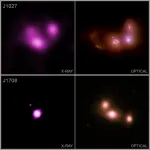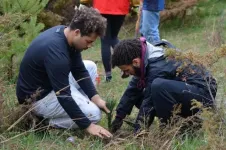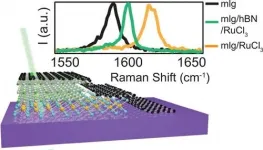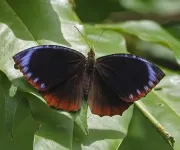(Press-News.org) When three galaxies collide, what happens to the huge black holes at the centers of each? A new study using NASA's Chandra X-ray Observatory and several other telescopes reveals new information about how many black holes are furiously growing after these galactic smash ups.
Astronomers want to learn more about galactic collisions because the subsequent mergers are a key way that galaxies and the giant black holes in their cores grow over cosmic time.
"There have been many studies of what happens to supermassive black holes when two galaxies merge," said Adi Foord of Stanford University, who led the study. "Ours is one of the first to systematically look at what happens to black holes when three galaxies come together."
She and her colleagues identified triple galaxy merger systems by cross-matching the archives - containing data that is now publicly available - of NASA's WISE mission and the Sloan Digital Sky Survey (SDSS) to the Chandra archive. Using this method they found seven triple galaxy mergers located between 370 million and one billion light years from Earth.
Using specialized software Foord developed for her Ph.D. at the University of Michigan in Ann Arbor, the team went through Chandra data targeting these systems to detect X-ray sources marking the location of growing supermassive black holes. As material falls toward a black hole, it gets heated to millions of degrees and produces X-rays.
Chandra, with its sharp X-ray vision, is ideal for detecting growing supermassive black holes in mergers. The associated X-ray sources are challenging to detect because they are usually close together in images and are often faint. Foord's software was developed specifically to find such sources. Data from other telescopes was then used to rule out other possible origins of the X-ray emission unrelated to supermassive black holes.
The results from Foord and the team show that out of seven triple galaxy mergers there is one with a single growing supermassive black hole, four with double growing supermassive black holes, and one that is a triple. The final triple merger they studied seems to have struck out with no X-ray emission detected from the supermassive black holes. In the systems with multiple black holes, the separations between them range between about 10,000 and 30,000 light years.
"Why do we care about the hitting percentage of these black holes?" said co-author Jessie Runnoe of Vanderbilt University in Nashville, Tenn. "Because these statistics can tell us more about how black holes and the galaxies they inhabit grow."
Once they found evidence for bright X-ray sources as candidates for growing supermassive black holes in the Chandra data, the researchers incorporated archival data from other telescopes. Like a second umpire conferring about the original call, these data backed up the idea that multiple black holes were present in the merged galaxies.
To make these calls the authors studied infrared data from the WISE mission, the Infrared Astronomical Satellite, and the Two Micron All Sky Telescope to see how quickly stars are forming in the different galaxies in their survey. This allowed them to estimate how many of the detected X-rays are likely to come from X-ray emitting systems containing massive stars, rather than a growing supermassive black hole. Because such star systems are young they are more common when stars are forming more quickly. Foord and her colleagues used this technique to conclude that one of the X-ray sources they found is likely from a collection of X-ray emitting star systems.
The Chandra and WISE data show that the system with growing supermassive black holes has the largest amount of dust and gas. This matches theoretical computer simulations of mergers that suggest higher levels of gas near black holes are more likely to trigger rapid growth of the black holes.
Studies of triple mergers can help scientists understand whether pairs of supermassive black holes can approach so close to each other that they make ripples in spacetime called gravitational waves. The energy lost by these waves will inevitably cause the black holes to merge.
The Laser Interferometer Gravitational Wave Observatory (LIGO) and Virgo array in Europe have shown astronomers that stellar-mass black holes create gravitational waves and merge, but it is not known if supermassive black holes do.
"There is a "nightmare scenario" where supermassive black holes cannot lose enough energy to come close together and make gravitational waves" said co-author Michael Koss of Eureka Scientific in Oakland, California. "If this is the case then projects like LISA and pulsar timing arrays won't have any supermassive black hole mergers to detect".
However, gravitational interactions from a third supermassive black hole may prevent this stalling process. Studies of supermassive black holes in systems where three galaxies are merging are therefore important for understanding whether the nightmare scenario might apply.
The system with three growing supermassive black holes had previously been reported by Ryan Pfeifle of George Mason University in Fairfax, Virginia in a Chandra press release and an October 2019 paper in The Astrophysical Journal (preprint here), and a team led by Xin Lui of the University of Illinois at Urbana-Champaign in a December 2019 paper in The Astrophysical Journal (preprint here). This latest result helps put that discovery into context of other triple mergers of galaxies.
Foord presented the new study at the 237th meeting of the American Astronomical Society, which is being held virtually from January 11-15, 2021. Two papers describing this work have recently been accepted for publication in The Astrophysical Journal and preprints are available here and here.
INFORMATION:
The Infrared Astronomical Satellite is a joint venture of NASA and its counterparts in the Netherlands and the UK, and the Two Micron All Sky Telescope is a collaboration between the University of Massachusetts and NASA's Infrared Processing and Analysis Center.
NASA's Marshall Space Flight Center manages the Chandra program. The Smithsonian Astrophysical Observatory's Chandra X-ray Center controls science from Cambridge Massachusetts and flight operations from Burlington, Massachusetts.
The reproductive cycle of viruses requires self-assembly, maturation of virus particles and, after infection, the release of genetic material into a host cell. New physics-based technologies allow scientists to study the dynamics of this cycle and may eventually lead to new treatments. In his role as physical virologist, Wouter Roos, a physicist at the University of Groningen, together with two longtime colleagues, has written a review article on these new technologies, which was published in Nature Reviews Physics on 12 January.
'Physics has been used for a long time to study viruses,' says Roos. 'The laws of ...
In the inaugural issue of the journal Nature Aging a research team led by aging expert Linda P. Fried, MD, MPH, dean of Columbia University Mailman School of Public Health, synthesizes converging evidence that the aging-related pathophysiology underpinning the clinical presentation of phenotypic frailty (termed as "physical frailty" here) is a state of lower functioning due to severe dysregulation of the complex dynamics in our bodies that maintains health and resilience. When severity passes a threshold, the clinical syndrome and its phenotype are diagnosable. This paper summarizes the evidence meeting criteria for physical frailty as a product of complex system dysregulation. ...
Astronomers have curated the most complete list of nearby brown dwarfs to date thanks to discoveries made by thousands of volunteers participating in the Backyard Worlds citizen science project. The list and 3D map of 525 brown dwarfs -- including 38 reported for the first time -- incorporate observations from a host of astronomical instruments including several NOIRLab facilities. The results confirm that the Sun's neighborhood appears surprisingly diverse relative to other parts of the Milky Way Galaxy.
Mapping out our own small pocket of the Universe is a time-honored quest within astronomy, and ...
NEW YORK (January 14) -- A new study co-authored by researchers from the Wildlife Conservation Society's (WCS) Global Conservation Program and the University of British Columbia (UBC) Faculty of Forestry introduces a classification called Resistance-Resilience-Transformation (RRT) that enables the assessment of whether and to what extent a management shift toward transformative action is occurring in conservation. The team applied this classification to 104 climate adaptation projects funded by the WCS Climate Adaptation Fund over the past decade and found differential responses toward transformation ...
A wide breadth of behaviors surrounding oral sex may affect the risk of oral HPV infection and of a virus-associated head and neck cancer that can be spread through this route, a new study led by researchers at the Johns Hopkins Kimmel Cancer Center suggests. These findings add nuance to the connection between oral sex and oropharyngeal cancer -- tumors that occur in the mouth and throat -- and could help inform research and public health efforts aimed at preventing this disease.
The findings were reported Jan. 11 in the journal Cancer.
In the early 1980s, researchers realized that nearly all cervical cancer is caused by the human papillomavirus (HPV), a DNA virus from the Papillomaviridae family. Although about 90% of HPV infections ...
The higher a person's income, the more likely they were to protect themselves at the early stages of the Covid-19 pandemic in the United States, Johns Hopkins University economists find.
When it comes to adopting behaviors including social distancing and mask wearing, the team detected a striking link to their financial well-being. People who made around $230,000 a year were as much as 54% more likely to increase these types of self-protective behaviors compared to people making about $13,000.
"We need to understand these differences because we can wring our hands, and we can blame and shame, but in a way it doesn't matter," said Nick Papageorge, the Broadus Mitchell Associate Professor of Economics. "Policymakers just need to recognize who is going ...
Physicists at Washington University in St. Louis have discovered how to locally add electrical charge to an atomically thin graphene device by layering flakes of another thin material, alpha-RuCl3, on top of it.
A paper published in the journal Nano Letters describes the charge transfer process in detail. Gaining control of the flow of electrical current through atomically thin materials is important to potential future applications in photovoltaics or computing.
"In my field, where we study van der Waals heterostructures made by custom-stacking atomically ...
ATLANTA--Compared to standard machine learning models, deep learning models are largely superior at discerning patterns and discriminative features in brain imaging, despite being more complex in their architecture, according to a new study in Nature Communications led by Georgia State University.
Advanced biomedical technologies such as structural and functional magnetic resonance imaging (MRI and fMRI) or genomic sequencing have produced an enormous volume of data about the human body. By extracting patterns from this information, scientists can glean ...
Philadelphia, January 14, 2021--Based on preclinical studies of an investigational drug to treat peripheral nerve tumors, researchers at Children's Hospital of Philadelphia (CHOP) as part of the Neurofibromatosis Clinical Trials Consortium have shown that the drug, cabozantinib, reduces tumor volume and pain in patients with the genetic disorder neurofibromatosis type 1 (NF1). The results of the Phase 2 clinical trial, co-chaired by Michael J. Fisher, MD at CHOP, were published recently in Nature Medicine.
"This is the second class of drugs to demonstrate ...
Many animal and insect species use Batesian mimicry - mimicking a poisonous species - as a defense against predators. The common palmfly, Elymnias hypermnestra (a species of satyrine butterfly), which is found throughout wide areas of tropical and subtropical Asia, adds a twist to this evolutionary strategy: the females evolved two distinct forms, either orange or dark brown, imitating two separate poisonous model species, Danaus or Euploea. The males are uniformly brown. A population group is either entirely brown (both males and females) or mixed (brown males and orange females).
City College of New York entomologist David Lohman and his collaborators studied the genome of 45 samples representing 18 subspecies across Asia to determine ...



